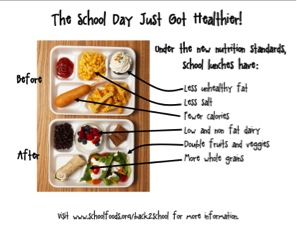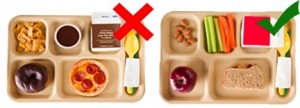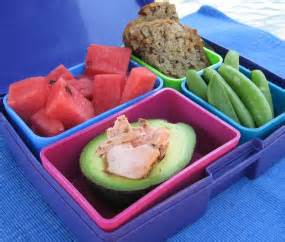 As summer is coming to an end and we start thinking about the inevitable back to school shopping list, add some new groceries to your list. Believe it or not, a recent study from the 2012-2013 school year looked at elementary schools in Virginia and found that the home-packed lunches lacked in nutritional value when compared to the school-provided lunches! To be specific, they contained approximately 100 more calories, 8 more grams of fat, and 10 more grams of sugar than school lunches. With the recent updates to the National School Lunch Program, nutritionally balanced meals are being offered, in addition to a list of not so nutritionally balanced choices being officially omitted from the options.
As summer is coming to an end and we start thinking about the inevitable back to school shopping list, add some new groceries to your list. Believe it or not, a recent study from the 2012-2013 school year looked at elementary schools in Virginia and found that the home-packed lunches lacked in nutritional value when compared to the school-provided lunches! To be specific, they contained approximately 100 more calories, 8 more grams of fat, and 10 more grams of sugar than school lunches. With the recent updates to the National School Lunch Program, nutritionally balanced meals are being offered, in addition to a list of not so nutritionally balanced choices being officially omitted from the options.
 That being said, for those of you that still enjoy packing a lunch for your kiddos as you send them off to school, consider these statistics. Approximately 40% of children bring a packed lunch, yet only 34% of those packed lunches contain fruit, 11% contain vegetables, and only 3% contain milk! Angela Lemond, a pediatric dietitian from Plano, Texas, states, “Start with a protein and a whole grain, then a fruit or vegetable serving. A dairy serving such as milk, cheese, or yogurt is also important to support bone growth and development.” In cases such as this, it is important to focus more on what goes into the lunch instead of what you should leave out.
That being said, for those of you that still enjoy packing a lunch for your kiddos as you send them off to school, consider these statistics. Approximately 40% of children bring a packed lunch, yet only 34% of those packed lunches contain fruit, 11% contain vegetables, and only 3% contain milk! Angela Lemond, a pediatric dietitian from Plano, Texas, states, “Start with a protein and a whole grain, then a fruit or vegetable serving. A dairy serving such as milk, cheese, or yogurt is also important to support bone growth and development.” In cases such as this, it is important to focus more on what goes into the lunch instead of what you should leave out.
For example, entrée choices for lunches could include a sandwich on whole grain bread with nut or seed butter or lean sliced meat, such as turkey or chicken breast, a whole grain tortilla wrap with hummus and veggies, or whole wheat pasta salad with tuna or chicken.  For a side snack, choose fresh fruit slices, low-fat cheese or yogurt, avocado slices, or raw veggies and chase it all down with water or low-fat milk or milk alternative! Cassie Vanderwall, Clinical nutritionist at the University of Wisconsin Health Pediatric Fitness Clinic, notes, “We want to prepare our kids just like we would an athlete, with energy that’s going to provide a stable source of nutrients and energy to feed their brain throughout the entire school day.” All of the above choices will keep your kids feeling energized throughout the day as they continue to focus from class to class. Providing whole grain instead of white bread will keep your kids running on steady energy through school, recess, and sports practices after school as opposed to the spike and crash that simple carbohydrates tend to cause.
For a side snack, choose fresh fruit slices, low-fat cheese or yogurt, avocado slices, or raw veggies and chase it all down with water or low-fat milk or milk alternative! Cassie Vanderwall, Clinical nutritionist at the University of Wisconsin Health Pediatric Fitness Clinic, notes, “We want to prepare our kids just like we would an athlete, with energy that’s going to provide a stable source of nutrients and energy to feed their brain throughout the entire school day.” All of the above choices will keep your kids feeling energized throughout the day as they continue to focus from class to class. Providing whole grain instead of white bread will keep your kids running on steady energy through school, recess, and sports practices after school as opposed to the spike and crash that simple carbohydrates tend to cause.
 There are many other great resources for packing healthy lunches. Check out these ideas from Cooking Light, Food Network, Good Housekeeping, and 100 Days of Real Food.
There are many other great resources for packing healthy lunches. Check out these ideas from Cooking Light, Food Network, Good Housekeeping, and 100 Days of Real Food.
If your children have any food allergies or intolerance, see these tips for managing food allergies in the cafeteria. These nut-free school lunch ideas are great for kids with nut allergies and without! For ideas for gluten-free lunches check out these suggestions. Also, remember to check your school’s policy on food allergies before packing your child’s lunch.
Share your favorite healthy school lunch ideas with us on Facebook!
Be Well,
Kellsey O’Donnell
Eat Fit Health Intern
Graduate Student, Drexel University
MS in Human Nutrition, 2016